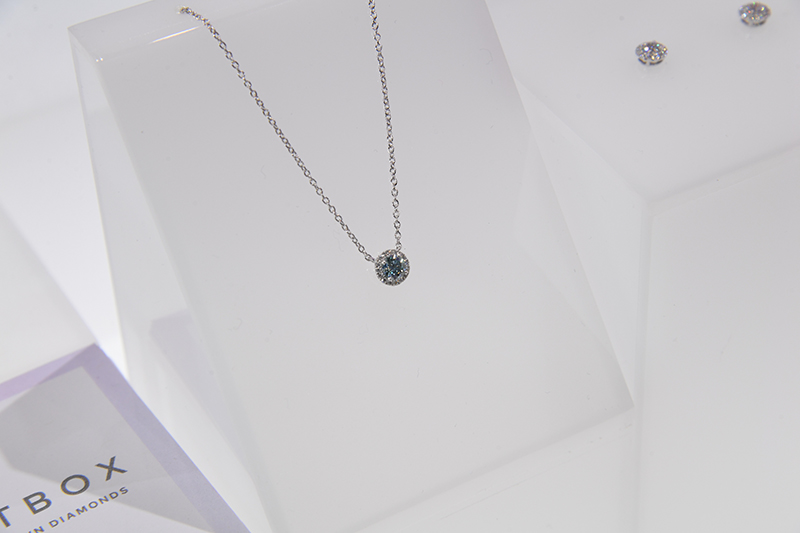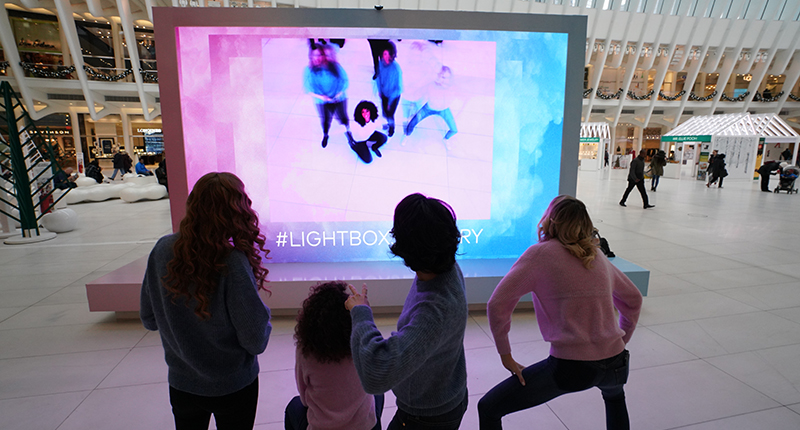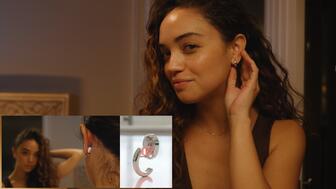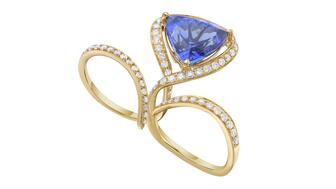Set in a Tiffany & Co. necklace, it sold for $4.2 million, the highest price and price per carat paid for a Paraíba tourmaline at auction.
Consumers Saw Lightbox. Here’s What They Wanted to Know
At a pop-up shop in New York, De Beers is giving the public the chance to see its lab-grown line in person for the first time.

New York—De Beers used to spread the message that “A Diamond Is Forever” around Grand Central Station at holiday time, appealing to the 750,000+ commuters crisscrossing the classic transit hub every day.
This year, the diamond miner and marketer is at it again, but now its promoting lab-grown diamonds at the Oculus, the two-year-old, ultra-modern transit hub at the site of the rebuilt World Trade Center.
Call it a sign of the times.
Back in September De Beers launched Lightbox, a line of moderately priced (the most expensive pieces on the site, 1-carat diamonds set in 10-karat gold, are $1,000) fashion jewelry set with man-made diamonds grown by its Element Six arm in the United Kingdom.
The line is fairly limited at this point—just blue, pink and white lab-grown diamonds set in either pendants or earrings, with blue and pink studs the runaway successes so far, said Lightbox Head of Marketing Sally Morrison.
It is sold online only, which means consumers haven’t had a chance to see, touch and feel it—until this week.
On Monday, Lightbox opened a pop-up shop at the Oculus, and this editor popped by Tuesday afternoon around 3:30, shortly before evening rush hour was in full effect, and lingered until a little after 5.
What became apparent in that time is this: Consumers are drawn in when they see something sparkly.
There was a constant stream of people in and out of the 20’ x 20’ structure the entire time.
But they don’t know as much about lab-grown diamonds as many in the trade might think, and there is confusion about how man-made diamonds differ from simulants.
“I’m intrigued. I’ve never heard of this before,” one woman wearing natural diamond stud earrings said as she entered the Lightbox space.
After the product and pricing was explained to her—it starts at $200 for a quarter carat and goes up to $800 for 1 carat, plus the cost of the setting—she seemed to like the idea, noting that lab-grown diamonds are “an accessible way to be able to give people a diamond.”
Multiple customers asked about the difference between lab-grown diamonds and CZ, and between the stones and another diamond simulant, moissanite, echoing the comments consumers made when National Jeweler conducted an informal poll on lab-grown diamonds four years ago.
There were also a lot of questions about how the quality of lab-grown diamonds compare
“There’s a lot of education to do, not just about our product but the category in general,” Morrison said Tuesday afternoon in an interview at the Lightbox booth. “There’s a lot of confusion.”

Morrison and her team—many of whom were clad in on-brand blue and pink sweaters—are learning that first-hand while manning the pop-up, which is set to remain open through Sunday.
Like the Blue Nile “webrooms,” the Lightbox pop-up is not selling the product it’s showing; customers cannot walk out with a little box of jewelry in their hands.
They can, however, order jewelry from an iPad set up in the left-front corner of the pop-up, or shop on the brand’s website after they leave.

De Beers announced just before the Las Vegas jewelry trade shows it would begin selling lab-grown diamonds, sparking a flurry of commentary in the industry.
Some applauded the move, claiming that the current crop of companies selling man-made diamonds are overcharging and De Beers’ pricing model would serve as a regulator.
Some existing sellers of lab-grown diamonds accused De Beers of predatory pricing, while retailers worried how Lightbox would impact sales of lower-end diamond fashion jewelry in their stores and bemoaned the addition of another supplier selling direct to the public.
RELATED CONTENT: Is De Beers’ Lab-Grown Line a Fit for Signet?The company has said it will make Lightbox available to brick-and-mortar jewelers in the future.
Morrison said Tuesday a brick-and-mortar test run is planned for 2019, though De Beers has not yet decided which retailers will carry the line.
In the meantime, the man-made diamonds continue to move online and Morrison is not ruling out the possibility of another pop-up.
She said that selling online and having this physical space is teaching them a lot about what consumers do, and don’t, like about the product.
“I think it’ll be better to go into brick-and-mortar (stores) when we know more about the customer and the response to the product,” she said.
The Latest

Take luxury gifting to new heights this holiday season with the jeweler’s showstopping 12-carat sphene ring.

This year's theme is “Unveiling the Depths of the Ocean.”

How Jewelers of America’s 20 Under 40 are leading to ensure a brighter future for the jewelry industry.

In its annual report, Pinterest noted an increase in searches for brooches, heirloom jewelry, and ‘80s luxury.


Starting Jan. 1, customers can request the service for opal, peridot, and demantoid garnet.

The 111-year-old retailer celebrated the opening of its new location in Salem, New Hampshire, which is its third store in the state.

Roseco’s 704-page catalog showcases new lab-grown diamonds, findings, tools & more—available in print or interactive digital editions.

The filmmaker’s personal F.P. Journe “FFC” prototype was the star of Phillips’ recent record-setting watch auction in New York.

The new location in the Design District pays homage to Miami’s Art Deco heritage and its connection to the ocean.

Inflations, tariffs, and politics—including the government shutdown—were among consumers’ top concerns last month.

“Longtime favorite” presenters, as well as first-time speakers, will lead talks and workshops at the annual event in Tucson next year.

Silas Smith of Meridian Metalworks won the challenge with his pendant that blends Australian and American landscapes.

The sale of the 31.68-carat, sunset-hued stone was part of Sotheby’s first series of events and auctions in Abu Dhabi.

Most customers who walk into your store this month have made up their minds. Your job is to validate their choice, Emmanuel Raheb writes.

The collection features characters and motifs from Ukrainian folklore, including an enchanted mirror and a magic egg.

MatrixGold 3.11, the newest version of the jewelry design program, offers more flexibility, precision, and creative control.

The pavilion will be part of the 2026 JA New York Spring show, scheduled for March 15 to 17.

Kadet, a 1994 National Jeweler Retailer Hall of Fame inductee, helped grow the family-owned retailer in the Chicago area and beyond.

Billed as the world’s smallest wearable, Lumia Health’s new smart earrings have a health tracker subtly embedded in the back.

Don’t let those with December birthdays feel blue. Help them celebrate their month with blue zircon, turquoise, and tanzanite.

The new pink sapphire version of the piece dances with its wearer in the brand’s “Icons After Dark” holiday campaign.

A choice that’s generated a lot of commentary, Pantone says “Cloud Dancer” marks a fresh start and encourages relaxation and creativity.

The manufacturer’s holiday campaign features a gift guide filled with trending designs and jewelry that can be personalized.

The man was charged with theft, accused of ingesting the necklace while in a jewelry store in Auckland, New Zealand.

The Florida independent expanded its store from 8,000 to 14,000 square feet, fulfilling the vision of its late co-founder, Jim Dunn.

Sponsored by De Beers Group


























